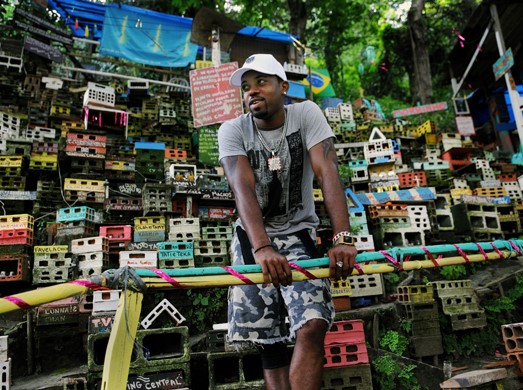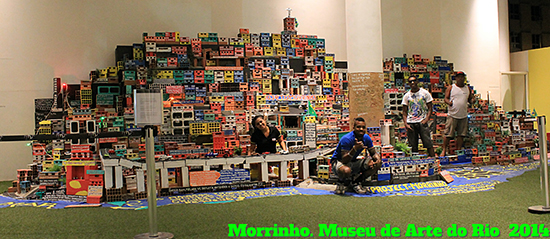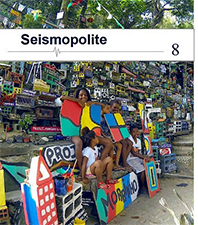December 10, 2014
Project Morrinho: fighting the grand narrative of
the favela
Written by Luisa Santos
In current discourse, the word favela connotes social problems, segregation and urban violence. A historical reading, however, reveals that the favela has been a topic of debate for at least a century, concurrent with a chain of images and representations that diverge from the social constructions that politicians, writers and social scientists have built up over the years in dealing with this particular social and urban phenomenon (Valladares, 2009). Looking at the origin of the word favela, it was first cited in 19th century Portuguese dictionaries, referring to the favela tree which was commonly found in Bahia[i].
The socio-cultural context of the Favela: a grand-narrative
After the Guerra de Canudos (Canudos War) that took place in Bahia between 1895 and 1896, government soldiers, who had lived amongst favela trees[ii], trailed to Rio de Janeiro to get their expected payment for war service. They settled on one of Rio’s hills and gave it the name “Morro da Favela” because of the tree that prospered in the location of their victory against the rebels of Canudos War. They waited for their payment but it never came, so they decided not to leave the Morro da Favela, which became the first favela in history.

Many descriptions of the favela in the first half of the 20th century appeared in the form of journalistic or historical writing. Euclides da Cunha’s well-known book Os Sertões (1902) covers the Canudos War and describes the coast versus the back lands as the opposition between cultured and uncultured, making a comparison to explain the difference between the favela and the city. Ironically, the history of the favelas was thus written as one of land invasion by poverty-stricken migrants, impoverished soldiers, turning their status as emissaries of the central government upside down.
In essays of architects, social workers, and doctors that entered the communities in the beginning of the 20th century, the favela was described as the wrong way of life, poor and dirty. This period was highly significant because it created the image of favela as the habitat of the poor (Perlman, 1977), an idea that still prevails in popular representations and people’s mind during the 20th and 21st century.
As Brazil’s civil society expanded, growing attention and research concerning the favela, both from academics and politicians, led to NGOs increasingly entering these communities, setting up programs and doing their own research, adding to the growing body of literature and knowledge regarding the favela, as well as changing the perception of what a favela might really mean. In 2007, President Lula announced the Programa de Aceleração do Crescimento (Program for Acceleration and Growth), a four-year investment plan, which included the promotion of urban development for the favelas. There have been public policies from local governments specially directed at the favelas. In Rio de Janeiro, programs such as the Favela-Bairro[iii] and Rio Cidade[iv] have attempted to mitigate the problem of poverty and weak development within the favelas. The problem with these programs is that they are designed by people living on the outside , who come up with solutions to what they think might be the problems to solve. Usually, this leads to little participation and forms of change that are only short-time.
In order to truly change this perception of what a favela might mean, a first step would be, probably, to refer to its true-form, understanding and integrating the existing cultural references. The people living in favelas, maybe due to the lack of material resources, possess a “do-it-yourself” spirit and a “build-your-own” mentality. These were the founding characteristics of Project Morrinho, a project which, among other things, aims to change the dogmatic perception of the favelas. Nelcirlan Souza de Oliveira, a 14-year-old boy who had recently moved to Rio de Janeiro, created Project Morrinho in 1998.
Small stories of Favela do Pereirão through Project Morrinho
As a 14-year old boy, Oliveira was impressed with the architecture and style of life in the favela and decided to playfully reproduce this reality in his own backyard with bricks and paint left over from his father’s construction work. This diversion caught the attention of seven other local children, and what was once just a game turned into their reality and routine. In a short time, a miniature favela of 350 square meters took shape. Within the miniature urban world of Morrinho, they acted out a role-playing game with the numerous Lego-block avatars that inhabit the model, recreating life in this Rio’s favela, with samba performances and gangs cohabiting the same place. Currently, more than twenty teenagers are following the example of the founding members.
The project was never planned as a work of art but it was a very natural step to change itself from play to art. In 2001, the encounter between filmmaker and producer Fábio Gavião and Marco Oliveira with the young creators of the model was crucial for what is today Project Morrinho. The idea of Fábio Gavião and Marco Oliveira, when they climbed the hill of Pereira da Silva and first saw Morrinho, which was then not more than a visually beautiful play made by a lot of children, was to create a collaborative documentary with the young people from the community. As a proof of trust, but also as a means of producing a documentary as natural and collaborative as it could be, they left a digital camera and the group began recording their plays. These recordings turned into short films and were included in the documentary Deus sabe de tudo mas não é x9 (God knows everything but is not a snitch). By giving the camera to the children, and trusting them, the filmmakers contributed to the main aim of what became Project Morrinho: to change the negative perception of what a favela might be.
Robert Storr got to know about Morrinho through the work of the artist and photographer Paula Trope, who presented a photographic exhibition in partnership with Morrinho artists at the São Paulo Biennial in 2006. Storr simply showed up in the community and said he wanted the young creators to reproduce a model of Morrinho at the Venice Biennial. Robert Storr also wrote a very interesting piece about Morrinho, where he makes a parallel to the concept of social sculpture that was advocated by the conceptual artist and social activist Joseph Beuys. It is a very interesting parallel, as the community as a whole can be regarded as one great work of art to which each young creator contributes creatively.
The project has been able to use the attention it attracts to evolve, more than as a work of art, into an organisation with aspiration for social change. The creation of an NGO assured the authorial rights of the work and helped in communicating the project to get more resources for further development. Today, Morrinho is formed by four initiatives encompassing various disciplines, interests, and knowledge: TV Morrinho, Tourism at Morrinho, Expo Morrinho and Morrinho Social. Each initiative plays an important role in showing the vision of Project Morrinho and helps directly, contributing to the social, cultural and economic development of the surrounding areas.
Multidisciplinarity as a motor to achieve social change
It is not that Project Morrinho presents itself as a multidisciplinary project. It is the choice of this essay to describe it as such, following its success through the combination of disciplines, all with the same level of importance for the Project, and the collaborative practice within its four initiatives that constitute what is today an NGO, and, in the words of its creators, an organisation aspiring to social change: “In the first years of the NGO, between 2006 and 2008, we had resources from companies through Laws of Culture Incentive and more than half of the people working at the Morrinho were living in the community. The artists who initiated Morrinho had a radical change in their lives: in their self-esteem, in their way of speaking and believing in themselves. Above all, it’s a leisure space in the middle of community, created not by the public power or private enterprises but by its inhabitants. It’s a magical space, a micro-universe inside the universe of Brazilian favelas” (Serra & Oliveira, 2012). The multidisciplinary vision goes beyond the exact sciences and demands dialogue with the humanities and the social sciences, as well as with art, literature, and poetry.

Beyond teaching local youth the craft of constructing the model of Morrinho and how to use the space for various forms of play, Morrinho Social also attends to various kinds of popular education that NGOs offer in the communities. These programs include classes in citizenship education, youth leadership, and media arts education. Under the motto “Initiating a small revolution”, Morrinho sets its goals in offering an educational component: art-education, social conscience, and economic development. In both formal and informal levels, these values make use of disciplines such as art, education, sociology, psychology, and economy.
Multidisciplinarity is very important in Project Morrinho, with its various initiatives, as it is part of the key for its success. Project Morrinho is a community-based organisation, and collaboration is one of the keywords in the community as well as among the volunteers: each individual shares a different knowledge in the different initiatives (from TV production to exhibitions and guided tours to tourism). Multidisciplinarity contributes to a better involvement of the community making the project more appealing and sustainable, even if facing difficulties, because when one part of the project does not work as it should, there is always another part of the project that supports it. This diversity of interests leads to a reinvention of networks as well as artistic expressions,and to a realignment of narratives of identity, to make contact with the pulse of wider social, disciplinary and cultural change. The work at Project Morrinho has drawn its team into the areas of urban regeneration and planning. At the moment, Project Morrinho has more in common with members of tenants and action groups, radical planners and cultural geographers, than it does with artists as it did in its early steps. Morrinho emerged out of the favelas and targeted favela publics but has expanded well beyond favela boundaries to reach national and international partners. Morrinho is political also in this sense, and openly owns an ideology.
Even though Morrinho’s leaders and participants are not afraid to engage with markets and make money so that they can be financially independent from sponsors and the state, they look at outsiders with fear and would not trust someone outside the community to play the role of a project manager, not only because of being an outsider to the community but also because project management is not seen as something essential by the authors. They seem to think that art is in the centre of the project and that there is not a need to plan too much as that is not understood as creative. This attitude is certainly not limited toProject Morrinho but is also common in Arts as a discipline. One often seems to fear that involving scientific disciplines in the process of creating art projects takes away the creative spark of the project. Notwithstanding, if we look to the history of scientific disciplines such as Project Management, we find that chaos, creativity and complexity are often seen to lie at the core of projects. Interestingly, the field of Project Management also demonstrates a preconceived idea of Arts, which leads many professional project managers to conclude that art projects and projects initiated in NGOs are incapable of understanding and dealing with planning and structure (PM4NGOs 2011; Cropper 2013). It might be true that a lot of art projects look, and often are, chaotic, but this does not exclude serious attempts to plan, and many also succeed in finding ways to find stakeholders and fundraisers even if the process is not the same as in project management and even if there is still a lot to be improved.
Analysis of the characteristics, methods and actions of Morrinho shows that they are sui generis and innovative, showing an alternative to the grand narrative of project management. Their explicit aims are the recognition of the culture and rich potential of favela life-worlds, the demolition of urban barriers and the dialogical crossings that can produce long term changes both in the public sphere and in social and individual subjectivities. They openly compete with the drug trade for influence in the routes of socialisation open to young favela people and work as mediators of conflict in disputes between the drug factions, the police and favela dwellers. Their range of actions is extensive, engaging both favela communities and the larger public sphere of the city. They put emphasis on the regeneration of the built environment of favelas, on the construction of spaces for positive sociability and conviviality and on psychosocial interventions that aim to foster self-esteem, self-control and awareness for the transformation of individual and collective trajectories.
The structuring of everyday life takes a central role in the communities’ perception and is seen as vital for avoiding criminality and engaging people in meaningful activity. Participants explicitly say that Project Morrinho gives them something to do, something to commit to, an opportunity to be responsible. Project Morrinho’s motto, “a small revolution” proves, then, to be true. It is a small revolution because it is a local revolution within a specific community. But it also seems to have the potential to contribute to change the grand-narrative of the favela and this is not an insignificant change either.
Luisa Santos is an independant curator. She holds the MA-degree from the Royal College of Art, London, and is currently writing her PhD thesis at the Humboldt-Viadrina School of Governance, Berlin, with a scholarship from FCT - Fundação para a Ciência e Tecnologia.
[i] Valladares, Licia. Social sciences representations of favelas in Rio de Janeiro: A Historical perspective. 2009.
[ii] Favela trees are a typical plant of the Caatinga region, in Bahia, resistant to the long dry period to which they are submitted.
[iii] “Inter-American Development Bank funded this US$180 million “slum to neighborhood” project in 1995 in which it sought to integrate existing favelas into the fabric of the city through infrastructure upgrading and service increases. The project involves 253,000 residents in 73 communities. Key to the success of this large project was a committed and flexible city government and the use of intra- and extra-institutional partnerships with NGOs, the private sector, churches, and the general population. Especially instrumental was the use of grass-roots level infrastructure upgrading experts as project managers who could work easily with both the government and with the community members.” Source http://web.mit.edu/urbanupgrading/upgrading/case-examples/ce-BL-fav.html (August 2012)
[iv] “Rio Cidade Project was part of an urban intervention established in Rio, between 1995 and 2000, following the 90s urban investments, with strong influence from the politics applied at American and European cities, like Barcelona. “Rio Cidade” was part of one of the projects included in Rio de Janeiro´s City Strategy, under the subtitle “the urbanism is back to the city”. This plan was worked out on Cesar Maia´s council administration (1993-1996) and it was concluded in September, 1995.” Source http://www.ub.edu/geocrit/-xcol/338.htm (August 2012)
Literature:
Valladares, Licia. "Social sciences' representations of favelas in Rio de Janeiro: A Historical perspective." University of Texas at Austin, LANIC, 2009.










